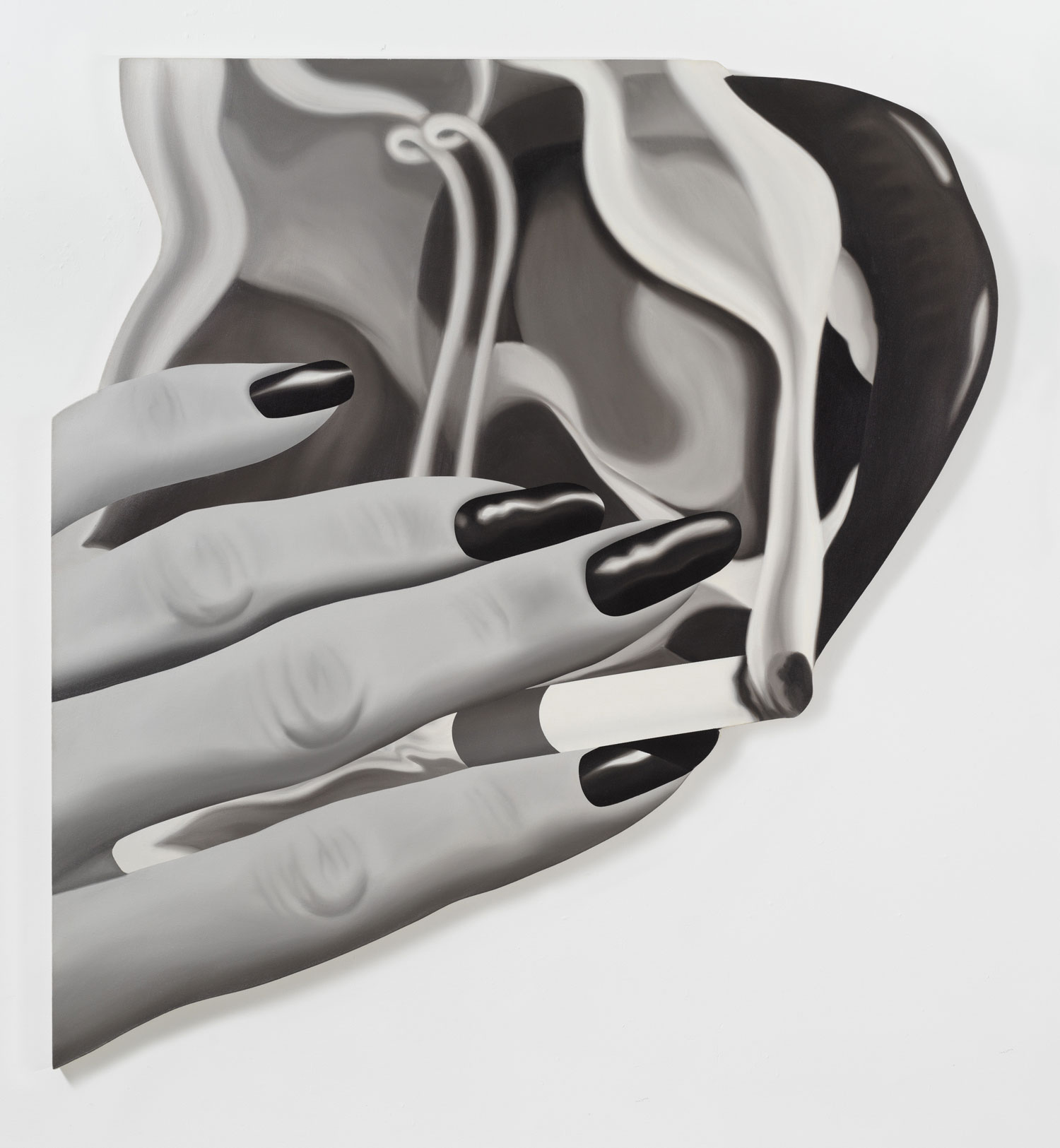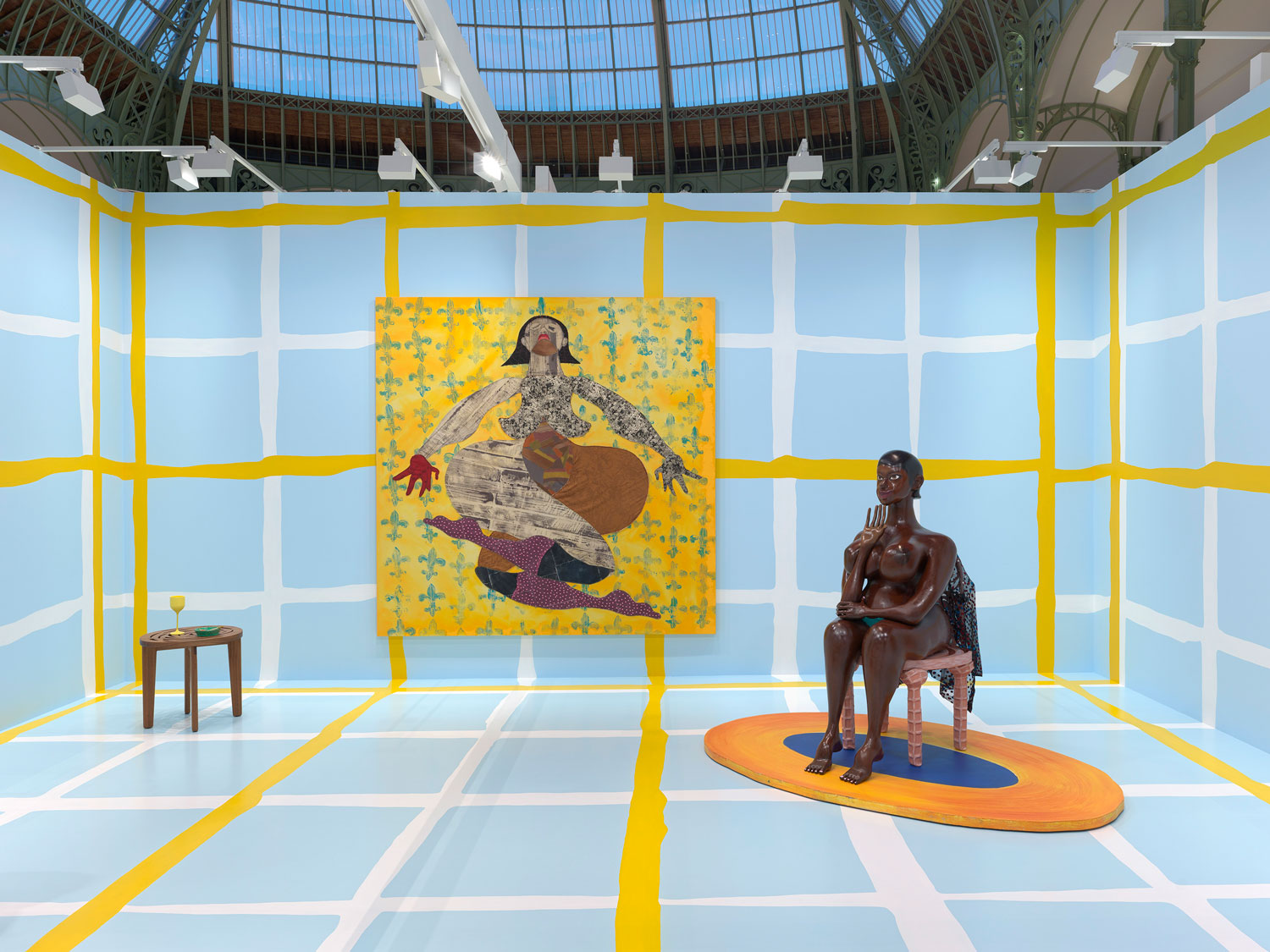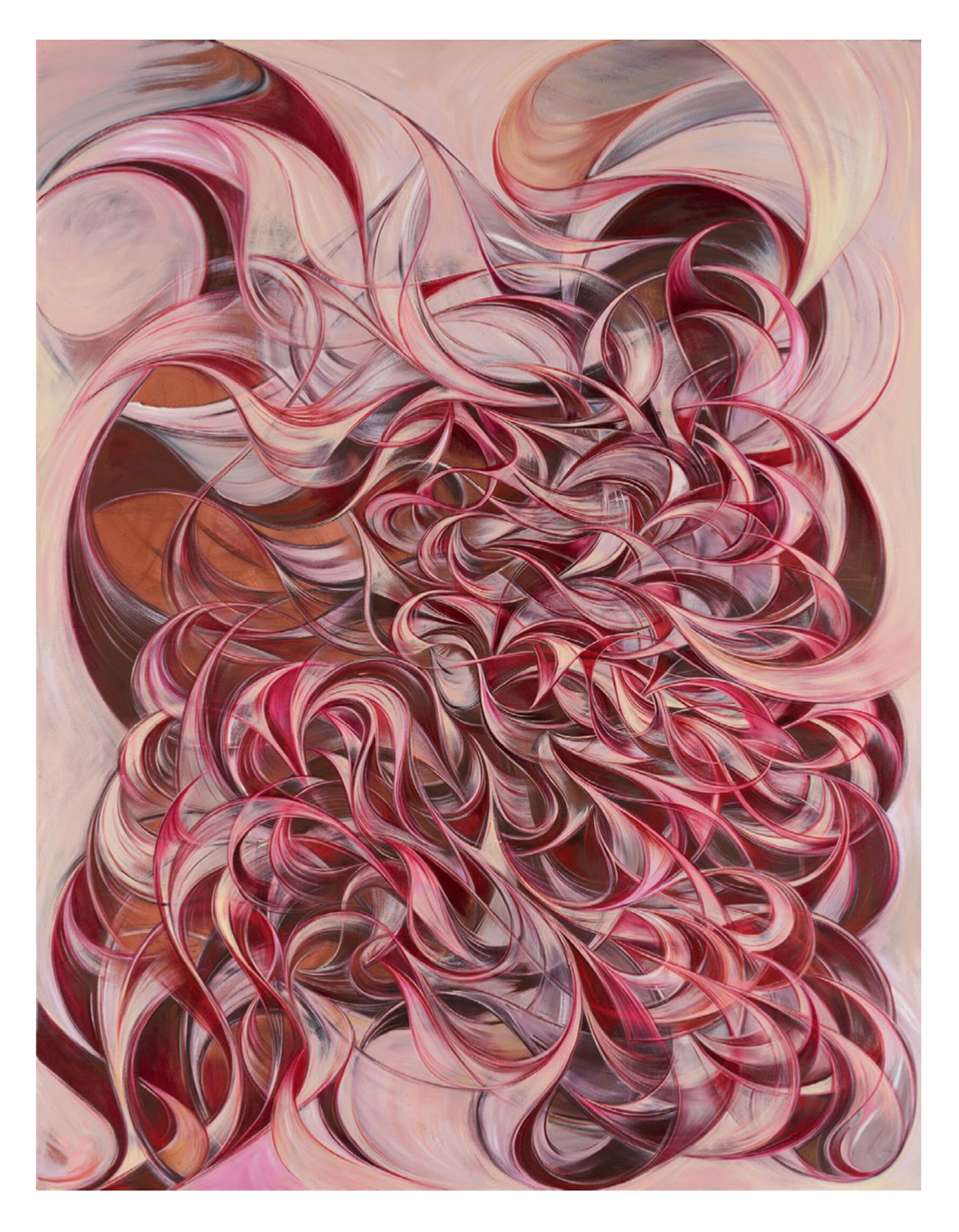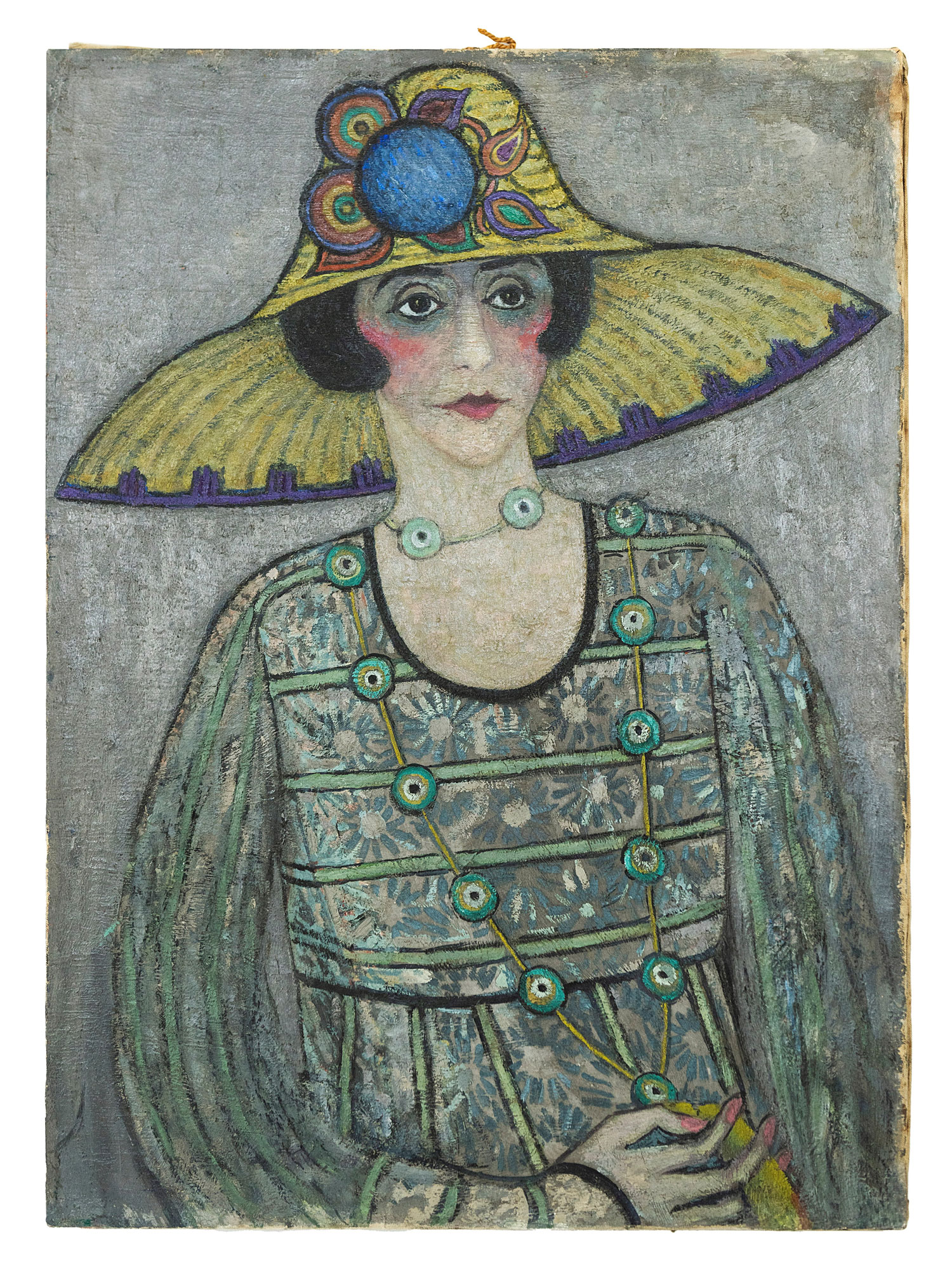Dynamically sited in the newly renovated Grand Palais, Art Basel returned to Paris for its third edition with a new home and a new name. Previously dubbed Paris + par Art Basel, it’s now officially known as Art Basel Paris, joining Art Basel, Art Basel Miami Beach, and Art Basel Hong Kong as one of the world’s top art fairs.
Featuring 195 galleries from 42 countries and territories, including 65 galleries operating spaces in France, the fair—taking place from October 18-20, 2024—sparkled on opening day as the sun lit the art through the venue’s massive glass roof and collectors, curators, critics, artists, and art lovers poured through the aisles and into the exhibitors’ art-filled booths.
Delving deep into all levels of the fair, from the emerging galleries on the upper balconies to the world’s leading galleries on the ground floor, Galerie had kept an eye out for recent discoveries and fresh masterpieces. These are the not-be-be-missed artworks that should be on every fairgoer’s list.

Tom Wesselmann, Smoker #20, 1975. Photo: Jeffrey Sturges. Courtesy the Estate of Tom Wesselmann and Gagosian
1. Tom Wesselmann at Gagosian
The subject of a lively survey at the Fondation Louis Vuitton in Paris, Tom Wesselmann is the toast of the town, with several of his famous Pop Art pieces also on view at the fair. Van de Weghe exhibited one of Wesselmann’s Great American Nude paintings while Gagosian, Lévy Gorvy Dayan, and Almine Rech presented large, amusingly shaped canvases from his celebrated Smoker series. Our favorite, however, was his striking, black-and-white painting Smoker #20, from 1975, prominently displayed on Gagosian’s outer wall.
The idea came to the artist in 1967 while drawing mouth studies of his friend and model Peggy Sarno. In the FLV exhibition, early 1970s photographic studies captured the film director and screenwriter Danièle Thompson exhaling swirling smoke, which became the point of departure for the later paintings. The thing that separates Smoker #20 from the rest of the gems in the series is that it was one of the few smoker paintings rendered without color. Presenting a disembodied, manicured hand holding a lit cigarette above an open mouth, the canvas depicts the action at an odd angle, as though the female subject was reclining in bed, which adds sexual overtones to an already alluring image.

Installation view, Tschabalala Self: My House, Galerie Eva Presenhuber, Art Basel Paris, Grand Palais, Paris. Photo: Annik Wetter. Courtesy the artist and Galerie Eva Presenhuber
2. Tschabalala Self at Galerie Eva Presenhuber
A solo booth presentation by New York-based artist Tschabalala Self, the eye-popping exhibition titled “My House,” featured paintings, sculptures, and functional furniture-like art objects, all displayed in a colorfully gridded realm. Her collaged canvases with sewn bits of patterned fabrics depict voluptuous Black women on vibrantly painted, ornate backgrounds. Likewise, her 3D printed, epoxy-resin, and painted sculptures portray a scantily dressed, busty black heroine inspired by Sarah Baartman, an African woman who was exhibited as a freak show attraction in 19th-century Europe under the name Hottentot Venus.
Concerned with the iconographic importance of the Black female body in contemporary culture, the presentation paid homage to a fictional Parisian woman of African descent. Borrowing from the aesthetics of modernist French painters like Henri Matisse, the artist created a theatrical environment depicting an uncanny home, complete with hand-carved African Mahogany furnishings and resin-cast accessories. Motivated by Self’s deep desire for Baartman to have lived a different life, this work was intended to right the wrongs of past and current representations of the Black female body in Parisian visual culture, and if properly understood, it might just start that dialogue.

Louise Bourgeois, Spider I, 1995. Photo: Christopher Burke. Courtesy the Foundation and Hauser & Wirth
3. Louise Bourgeois at Hauser & Wirth
Stocking its centrally located booth with modern masterworks by Kasmir Malevich, Louise Bourgeois, and Philip Guston, alongside paintings and sculptures by such living artists as Jeffrey Gibson, who is representing the United States in the Venice Biennale and just recently joined the gallery, and Frank Bowling, Hauser & Wirth had one of the busiest booths at the fair. The piece that immediately caught our eye when entering the booth was Louise Bourgeois’ 1995 bronze spider, clinging to a spot high on a wall.
Bourgeois first depicted the spider, which she saw as a tribute to her mother, who was a weaver and ran a tapestry restoration studio with her husband, in a 1947 drawing. She began making her iconic spider sculptures in the mid-1990s, with this particular bronze an exemplary early example. Bourgeois used the spider, a predator and protector, to symbolize the mother figure. Fascinated by this insect, she continued exploring it by creating five editions of Spiders (numbered I to V), three of which were made to be wall-mounted works. Smaller than many of her arachnid sculptures, Spider I grips the wall as if frozen, its eight legs frightenedly splayed in all directions.

Yuan Fang, Open Fire, 2024. Photo: ourtesy the artist and Skarstedt.
4. Yuan Fang at Skarstedt
Born in China and schooled in the United States, Yuan Fang received an MFA in 2022 from the School of Visual Arts in New York. One of the most talented young emerging artists currently working with abstraction, she paints layer upon layer of bold, swirling brushstrokes to create compelling compositions that quickly catch the eye and keep it in continuous motion. Beginning with looser background marks, including broad brushwork and paint pours, each gestural layer gets tighter, more physically engaging, and more intense. Fang’s sensual layering of curvilinear feminine forms creates a visual vortex that pulls the viewer into the action—creating a mesmerizing entanglement in the pictorial space rather than a traditional reading. Her 2024 painting Open Fire uses vivid colors and fluid forms to reflect the explosive energy the Brooklyn-based artist pours into her dynamic work.

Juliette Roche, Femme au chapeau, c. 1920. Photo: Sarkis Torossian. Courtesy Pauline Pavec
5. Juliette Roche at Galerie Pauline Pavec
Exhibiting her work as an emerging artist in Paris in the early 1900s, Juliette Roche was accepted into the Parisian art scene from an early age, thanks to her family’s connections to Jean Cocteau and other notable art world figures. Mentored by the Nabis group, who played a significant role in the transition from Impressionism and academic art to abstract art, symbolism, and the other early movements of modernism, she dabbled in Cubism and exhibited at the Salon des indépendants in 1913. Moving to New York with her future husband, the cubist Albert Gleizes, she became friends with Marcel Duchamp, Francis Picabia, and Florine Stettheimer, with whom she participated in Dada activities. In 1917, she helped Duchamp prepare the first exhibition of the Society of Independent Artists, where she presented Dadaist-inspired works.
Returning to France when the war ended, she continued to paint and had a retrospective exhibition in Montpelier in 1962. Still, her work was not highly considered until the 1990s, when it began to be rediscovered. Since then, there have been museum shows in cities across France, and the Centre Pompidou and the Los Angeles County Museum of Art have acquired her paintings. At the fair, the gallery, which now represents the artist’s estate, offered a marvelous selection of Roche’s stylized portraits and party scenes from 1912 to around 1950.

Takako Yamaguchi, Guide, 2024. Photo: Gene Ogami. Courtesy the artist and Ortuzar Projects.
6. Takako Yamaguchi at Ortuzar Projects
Another recent rediscovery by the American art market, Takako Yamaguchi was born in Japan and has lived and worked in Los Angeles since 1978. Originally associated with the Pattern and Decoration movement, her work has become more transcendental over time. Progressing with the theory of abstractions in reverse, she has worked stylistically backward from abstraction to illusionism, focusing her attention on artistic approaches that were displaced by modernity.
Exhibiting over the past 20 years primarily in Japan, other parts of Asia, and occasionally in Europe and the United States, her paintings were recently included in the 2024 Whitney Biennial, which sparked new interest in her sublime work. At the fair, the gallery presented a solo show of abstract seascapes, where clouds and waves were abstracted to the point of pattern. Dreamscapes that blend representation and abstraction, her paintings marvelously mix motifs from her Japanese heritage and Modernist art histories.

Niki de Saint Phalle, The White Goddess, 1963. Photo: Courtesy Galerie Georges-Philippe et Nathalie Vallois
7. Niki de Saint Phalle at Galerie Georges-Philippe et Nathalie Vallois
A model-turned-artist, Niki de Saint Phalle became an overnight success in the 1960s with paintings made by shooting a rifle at plaster-covered reliefs embedded with containers of paint, which would burst over their white surfaces. A media darling, the French-American charmer parlayed her fame into blockbuster museum shows, public art projects, and signature products that she used to wage a feminist battle against her time’s religious, political, and cultural patriarchy.
Her 1963 sculpture, The White Goddess, is undoubtedly a masterpiece of the Nouveaux Réalistes period. An early assemblage composed of plaster, paint, fabric, and found objects, the white figure is an icon of fertility. Covered with tiny baby dolls, plastic flowers, toy animals, skulls, and a motorcyclist, it’s a seminal piece after the shooting paintings the artist created in 1961 and before the celebrated Nana figures that she began in 1965. Widely lent for museum shows when it was part of the Renault art collection, it was put up for auction by the French car company this past summer and snapped up by the gallery, which saved it as the centerpiece of its sensational booth.
Cover: Art Basel Paris 2024 at the Grand Palais.
Photo: Courtesy of Art Basel

